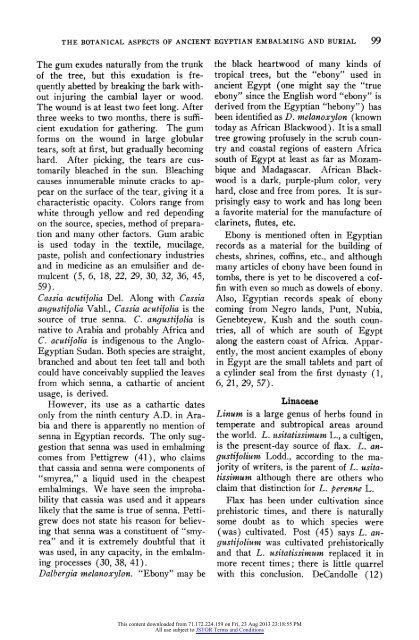The Botanical Aspects of Ancient Egyptian Embalming and Burial
The Botanical Aspects of Ancient Egyptian Embalming and Burial
The Botanical Aspects of Ancient Egyptian Embalming and Burial
You also want an ePaper? Increase the reach of your titles
YUMPU automatically turns print PDFs into web optimized ePapers that Google loves.
THE BOTANICAL ASPECTS OF ANCIENT EGYPTIAN EMBALMING AND BURIAL 99<br />
<strong>The</strong> gum exudes naturally from the trunk<br />
<strong>of</strong> the tree, but this exudation is frequently<br />
abetted by breaking the bark without<br />
injuring the cambial layer or wood.<br />
<strong>The</strong> wound is at least two feet long. After<br />
three weeks to two months, there is sufficient<br />
exudation for gathering. <strong>The</strong> gum<br />
forms on the wound in large globular<br />
tears, s<strong>of</strong>t at first, but gradually becoming<br />
hard. After picking, the tears are customarily<br />
bleached in the sun. Bleaching<br />
causes innumerable minute cracks to appear<br />
on the surface <strong>of</strong> the tear, giving it a<br />
characteristic opacity. Colors range from<br />
white through yellow <strong>and</strong> red depending<br />
on the source, species, method <strong>of</strong> preparation<br />
<strong>and</strong> many other factors. Gum arabic<br />
is used today in the textile, mucilage,<br />
paste, polish <strong>and</strong> confectionary industries<br />
<strong>and</strong> in medicine as an emulsifier <strong>and</strong> demulcent<br />
(5, 6, 18, 22, 29, 30, 32, 36, 45,<br />
59).<br />
Cassia acutifolia. Del. Along with Cassia<br />
angustifolia Vahl., Cassia acutifolia is the<br />
source <strong>of</strong> true senna. C. angustifolia is<br />
native to Arabia <strong>and</strong> probably Africa <strong>and</strong><br />
C. acutifolia is indigenous to the Anglo-<br />
<strong>Egyptian</strong> Sudan. Both species are straight,<br />
branched <strong>and</strong> about ten feet tall <strong>and</strong> both<br />
could have conceivably supplied the leaves<br />
from which senna, a cathartic <strong>of</strong> ancient<br />
usage, is derived.<br />
However, its use as a cathartic dates<br />
only from the ninth century A.D. in Arabia<br />
<strong>and</strong> there is apparently no mention <strong>of</strong><br />
senna in <strong>Egyptian</strong> records. <strong>The</strong> only suggestion<br />
that senna was used in embalming<br />
comes from Pettigrew (41), who claims<br />
that cassia <strong>and</strong> senna were components <strong>of</strong><br />
"smyrea," a liquid used in the cheapest<br />
embalmings. We have seen the improbability<br />
that cassia was used <strong>and</strong> it appears<br />
likely that the same is true <strong>of</strong> senna. Pettigrew<br />
does not state his reason for believing<br />
that senna was a constituent <strong>of</strong> "smyrea"<br />
<strong>and</strong> it is extremely doubtful that it<br />
was used, in any capacity, in the embalming<br />
processes (30, 38, 41).<br />
Dalbergiar melanoxylon. "Ebony" may be<br />
the black heartwood <strong>of</strong> many kinds <strong>of</strong><br />
tropical trees, but the "ebony" used in<br />
ancient Egypt (one might say the "true<br />
ebony" since the English word "ebony" is<br />
derived from the <strong>Egyptian</strong> "hebony") has<br />
been identified as D. melanoxylon (known<br />
today as African Blackwood). It is a small<br />
tree growing pr<strong>of</strong>usely in the scrub country<br />
<strong>and</strong> coastal regions <strong>of</strong> eastern Africa<br />
south <strong>of</strong> Egypt at least as far as Mozambique<br />
<strong>and</strong> Madagascar. African Blackwood<br />
is a dark, purple-plum color, very<br />
hard, close <strong>and</strong> free from pores. It is surprisingly<br />
easy to work <strong>and</strong> has long been<br />
a favorite material for the manufacture <strong>of</strong><br />
clarinets, flutes, etc.<br />
Ebony is mentioned <strong>of</strong>ten in <strong>Egyptian</strong><br />
records as a material for the building <strong>of</strong><br />
chests, shrines, c<strong>of</strong>fins, etc., <strong>and</strong> although<br />
many articles <strong>of</strong> ebony have been found in<br />
tombs, there is yet to be discovered a c<strong>of</strong>fin<br />
with even so much as dowels <strong>of</strong> ebony.<br />
Also, <strong>Egyptian</strong> records speak <strong>of</strong> ebony<br />
coming from Negro l<strong>and</strong>s, Punt, Nubia,<br />
Genebteyew, Kush <strong>and</strong> the south countries,<br />
all <strong>of</strong> which are south <strong>of</strong> Egypt<br />
along the eastern coast <strong>of</strong> Africa. Apparently,<br />
the most ancient examples <strong>of</strong> ebony<br />
in Egypt are the small tablets <strong>and</strong> part <strong>of</strong><br />
a cylinder seal from the first dynasty (1,<br />
6, 21, 29, 57).<br />
Linaceae<br />
Linum is a large genus <strong>of</strong> herbs found in<br />
temperate <strong>and</strong> subtropical areas around<br />
the world. L. usitatissimum L., a cultigen,<br />
is the present-day source <strong>of</strong> flax. L. angustifolium<br />
Lodd., according to the majority<br />
<strong>of</strong> writers, is the parent <strong>of</strong> L. usitatissimum<br />
although there are others who<br />
claim that distinction for L. perenne L.<br />
Flax has been under cultivation since<br />
prehistoric times, <strong>and</strong> there is naturally<br />
some doubt as to which species were<br />
(was) cultivated. Post (45) says L. angustifolium<br />
was cultivated prehistorically<br />
<strong>and</strong> that L. usitatissimum replaced it in<br />
more recent times; there is little quarrel<br />
with this conclusion. DeC<strong>and</strong>olle (12)<br />
This content downloaded from 71.172.224.159 on Fri, 23 Aug 2013 23:18:55 PM<br />
All use subject to JSTOR Terms <strong>and</strong> Conditions
















